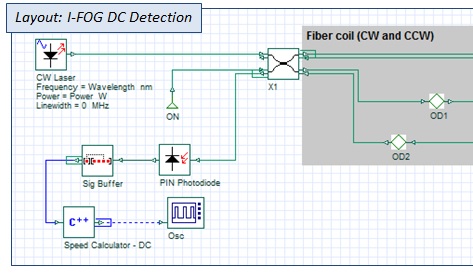- Applications
Applications
Optiwave software can be used in different industries and applications, including Fiber Optic Communication, Sensing, Pharma/Bio, Military & Satcom, Test & Measurement, Fundamental Research, Solar Panels, Components / Devices, etc..
Stay up-to-date with the latest updates
- Products
Products
- OptiSystem
- OptiInstrument
- OptiSPICE
- OptiFDTD
- OptiBPM
- OptiFiber
- OptiGrating
- OptiConverge
OptiSystemOptiSystem is a comprehensive software design suite that enables users to plan, test, and simulate optical links in the transmission layer of modern optical networks.
OptiInstrumentOptiInstrument addresses the needs of researchers, scientists, photonic engineers, professors and students who are working with instruments.
OptiSPICEOptiSPICE is the first circuit design software for analysis of integrated circuits including interactions of optical and electronic components. It allows for the design and simulation of opto-electronic circuits at the transistor level, from laser drivers to transimpedance amplifiers, optical interconnects and electronic equalizers.
OptiFDTDOptiFDTD is a powerful, highly integrated, and user friendly CAD environment that enables the design and simulation of advanced passive and non-linear photonic components.
OptiBPMOptiBPM is a comprehensive CAD environment used for the design of complex optical waveguides. Perform guiding, coupling, switching, splitting, multiplexing, and demultiplexing of optical signals in photonic devices.
OptiFiberOptiFiber The optimal design of a given optical communication system depends directly on the choice of fiber parameters. OptiFiber uses numerical mode solvers and other models specialized to fibers for calculating dispersion, losses, birefringence, and PMD.OptiGratingEmerging as a de facto standard over the last decade, OptiGrating has delivered powerful and user friendly design software for modeling integrated and fiber optic devices that incorporate optical gratings.
OptiConvergeOptiConverge is a collaborative integration framework that seamlessly combines two or more Optiwave products (e.g., OptiSystem, OptiSPICE, OptiFDTD, etc.) and other third party products into unified solutions. Designed to streamline complex workflows, it empowers users to achieve their goals faster by harnessing the collective power of our trusted Optiwave tools.- OptiSystem-Luceda
- OptiSPICE-Tanner
- OptiSystem-GDSFactory
- OptiSystem-FDTD/BPM
- OptiSystem-Tanner
- OptiSystem-OptiSPICE
- OptiSPICE-FDTD/BPM
- OptiSystem with other tools
Learn more about our products
- Downloads
Downloads
Download our 30-day Free Evaluations, lab assignments, and other freeware here.
Learn more about our 30-Day Evaluations
- Support
Support
Ask a questions

Want to learn more?
- Forum Login
- Applications
Applications
Optiwave software can be used in different industries and applications, including Fiber Optic Communication, Sensing, Pharma/Bio, Military & Satcom, Test & Measurement, Fundamental Research, Solar Panels, Components / Devices, etc..
Stay up-to-date with the latest updates
- Products
Products
- OptiSystem
- OptiInstrument
- OptiSPICE
- OptiFDTD
- OptiBPM
- OptiFiber
- OptiGrating
- OptiConverge
OptiSystemOptiSystem is a comprehensive software design suite that enables users to plan, test, and simulate optical links in the transmission layer of modern optical networks.
OptiInstrumentOptiInstrument addresses the needs of researchers, scientists, photonic engineers, professors and students who are working with instruments.
OptiSPICEOptiSPICE is the first circuit design software for analysis of integrated circuits including interactions of optical and electronic components. It allows for the design and simulation of opto-electronic circuits at the transistor level, from laser drivers to transimpedance amplifiers, optical interconnects and electronic equalizers.
OptiFDTDOptiFDTD is a powerful, highly integrated, and user friendly CAD environment that enables the design and simulation of advanced passive and non-linear photonic components.
OptiBPMOptiBPM is a comprehensive CAD environment used for the design of complex optical waveguides. Perform guiding, coupling, switching, splitting, multiplexing, and demultiplexing of optical signals in photonic devices.
OptiFiberOptiFiber The optimal design of a given optical communication system depends directly on the choice of fiber parameters. OptiFiber uses numerical mode solvers and other models specialized to fibers for calculating dispersion, losses, birefringence, and PMD.OptiGratingEmerging as a de facto standard over the last decade, OptiGrating has delivered powerful and user friendly design software for modeling integrated and fiber optic devices that incorporate optical gratings.
OptiConvergeOptiConverge is a collaborative integration framework that seamlessly combines two or more Optiwave products (e.g., OptiSystem, OptiSPICE, OptiFDTD, etc.) and other third party products into unified solutions. Designed to streamline complex workflows, it empowers users to achieve their goals faster by harnessing the collective power of our trusted Optiwave tools.- OptiSystem-Luceda
- OptiSPICE-Tanner
- OptiSystem-GDSFactory
- OptiSystem-FDTD/BPM
- OptiSystem-Tanner
- OptiSystem-OptiSPICE
- OptiSPICE-FDTD/BPM
- OptiSystem with other tools
Learn more about our products
- Downloads
Downloads
Download our 30-day Free Evaluations, lab assignments, and other freeware here.
Learn more about our 30-Day Evaluations
- Support
Support
Ask a questions

Want to learn more?
- Forum Login
Photonics Software for Defense Communications & More
Modern military installations and logistics demand technology that can scale up at short notice while remaining secure and reliable. Whether it’s telecommunications, encryption with quantum key distribution, or laser military applications, designing and testing this technology requires specialized software.
Optiwave software allows militaries to meet those demanding conditions with confidence.
- Engineers can develop rugged photonics systems for defense through extensive simulation tools with OptiSystem.
- Design specialized optical components with military-grade properties with OptiFDTD, OptiFiber and OptiGrating.
- Simulate the precise propagation of light through laser hardware with OptiBPM, or, use it for software-based optical design for satcom.
Key Features
- Safe and Secure Licenses: Maximize safety and security with offline USB dongles, no need to stay connected to the internet. Devices in harsh environments where military communication is limited will still be able to use Optiwave software.
- Direct Support: Our team is small, agile, and experienced. We can provide assistance at short notice if needed.
- Full Integration: Optiwave software is interoperable and flexible. For example, schematic files can be transferred from one tool to another, saving time and reducing errors.
- Always Reliable: Leading researchers and commercial giants rely on Optiwave’s software for its accuracy and reliability.
Defense Applications
- Fiber Bragg sensors for stress and strain sensing for premise intrusion detection.
- Phi-OTDR sensor for vibration sensor.
- Quantum key distribution and transmission over fiber (single mode, multimode, multicore), free space channel (FSO), or underwater wireless channel.
- Chaotic laser for secure military communication.
- Advanced modulation and coding schemes used for secure communication.
- Metasurfaces (including photonic crystals) for stealth applications and optical sensors.
- Microcavities for laser military applications (rangefinders, designators, etc.) and creating highly sensitive optical sensors.
- Nanoantennas and other plasmonics for secure data transmission and enhanced communications.
- Satcom optical design software for manufacturing couplers, allowing the efficient splitting of optical signals for telecommunications.
FAQs
How can photonics help with fiber optic communication for defense?
Photonics plays a crucial role in military communication, from providing massive bandwidth for high-speed data flow to allowing for the secure transmission of sensitive data. Fiber optics securely connect distant but important locations and are essential for military logistics.
Do I need to be a military logistics expert to use photonics tools?
No. Students, researchers, and other interested parties can freely use Optiwave software to learn more about the applications of photonics in the military. We provide detailed manuals and webinars to help non-specialists get started.
What is quantum key distribution (QKD)?
QKD relies on the principles of quantum mechanics to provide unprecedented security and encryption for communications. Instead of transmitting sensitive data, QKD involves sending secure keys that allow for the encryption/decryption of data. This method significantly reduces the chances of tampering and eavesdropping in military communications.


